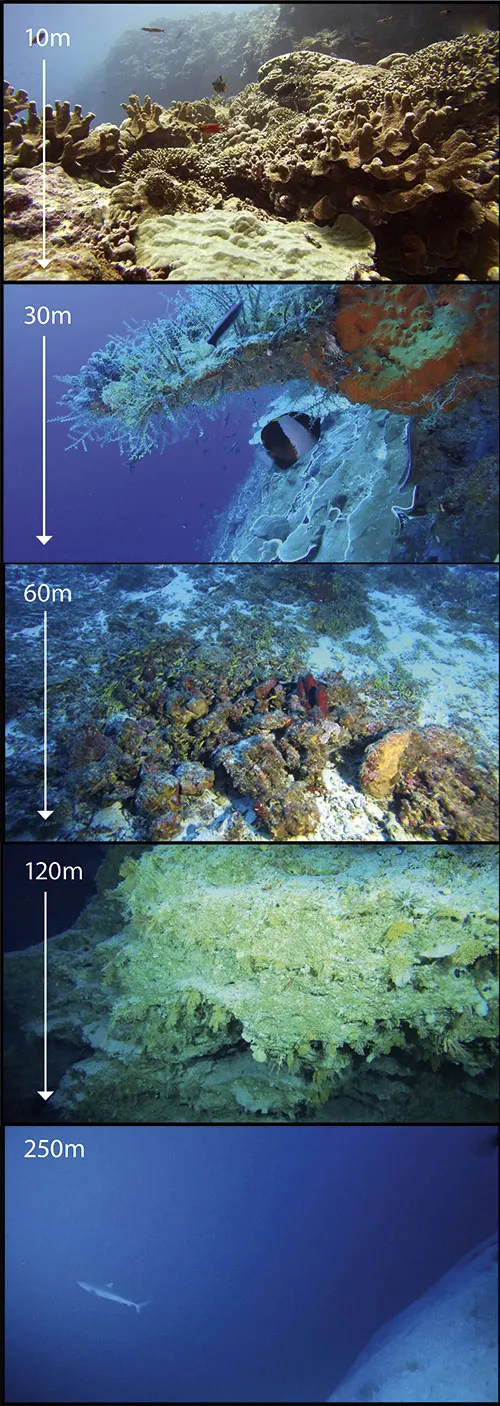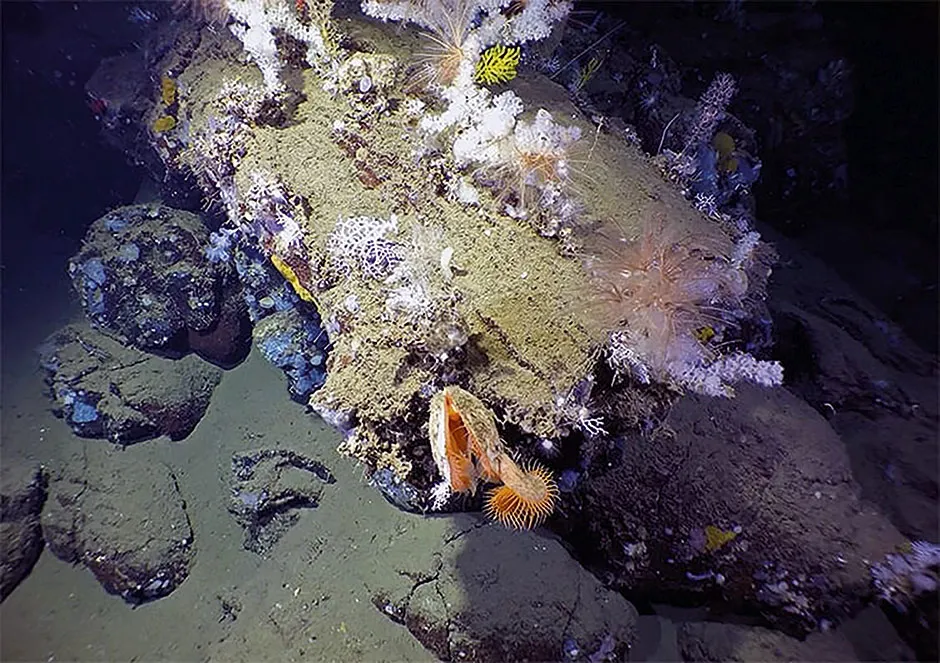On land, you’d struggle to find a mountain that hasn’t already been climbed. In contrast, in the deep sea there are thousands of unexplored peaks. Seamounts are submerged volcanoes, active or dormant, with foothills planted in the abyss and summits soaring up thousands of metres without breaking the sea surface.
These hidden mountains are some of the least known, but most abundant geological features on the planet. They form a fragmented habitat that covers an area rivalling the world’s tropical rainforests. As scientists learn more about seamounts, it’s becoming clear that these dramatic montane seascapes are rich oases of life that play a crucial role across the entire global ocean.

Currently, there’s no definitive count of the world’s seamounts, because locating and identifying them is not easy. Estimates suggest there are between 30,000 and more than 100,000 seamounts with peaks over 1,500m high. One of the biggest is Davidson Seamount off the California coast – 42km long, 8km wide and 2,280m tall. Taller still are seamounts that rise almost 5,000m from base to peak. Add in smaller peaks, 100m and higher, and the estimated global tally reaches into the millions.
Whatever the number of seamounts, scientists have studied only a few hundred. Dr Lucy Woodall is a senior research fellow at Oxford University and principal scientist at the research foundation Nekton, who has studied seamounts in the Atlantic, Indian and Southern Oceans. “It’s something I think about before every dive, that I’m probably the first human to see this bit of our planet, just because they’re so remote and so unexplored,” she says.
When exploring seamounts, scientists often encounter otherworldly forests of sponges and corals, including colourful, shrub-like colonies of gold and black corals that live for hundreds or even thousands of years. Deep-dwelling coral species already outnumber their distant relatives in the tropical shallows and new species are constantly being found. A recent expedition to the Galapagos Marine Reserve uncovered dozens of new species of corals and sponges growing on three previously unexplored seamounts.
Amid the expanses of mud-covered deep-sea floor, the rocky flanks of seamounts provide a footing for larvae of corals and sponges to settle on and grow. The corals and sponges then offer a habitat for other animals: starfish, anemones, snails, brittlestars, shrimp, squat lobsters and octopuses. Sharks lay their egg cases among the coral branches like Christmas tree decorations.

The dives Woodall and other seamount explorers undertake are often conducted from afar, using Remote Operated Underwater Vehicles, or ROVs. These deep-diving robots, roughly the size of a car, are deployed from a ship and controlled via cable. Equipped with high-definition cameras and robotic grippers, they become the scientists’ eyes and hands in the deep.
Seamount surveys are usually conducted from the base to the summit, along pre-determined transect lines, filming and photographing bands of habitat that can be scrutinised in detail later.
As well as surveying habitats and searching for new species, scientists also visit seamounts to hunt for novel molecules that could inspire new medicines. Deep-sea corals and sponges are proving to be especially useful because they produce a huge range of chemical defences.
Scientists get samples of tissue from the corals and sponges, then isolate and analyse the molecules produced by the animals and the microbes that live inside them. The samples are yielding all sorts of complex, toxic molecules that are showing great promise as new antibiotics, as well as treatments for cancers and pathogens such as tuberculosis and malaria.
Long-lived corals also keep a record of how the ocean has changed. By extracting traces of certain chemicals and measuring isotopes, scientists can estimate the temperature, pH and nutrients of seawater when different parts of the coral colony grew, some more than 4,000 years ago.
Read more about the deep sea:
- Everything you ever wanted to know about... the deep sea with Dr Jon Copley
- Deep sea mining: new depths
- How do squid survive extreme water pressure in the deep sea?
The least-known seamounts are those lying deepest underwater and yet, as deep-sea biologist Dr Astrid Leitner from the Monterey Bay Aquarium Research Institute points out, “those are actually the most common types of seamount on our planet”.
In 2018, while she was a PhD student at the University of Hawai’i at Manoa, Leitner took part in a seamount-finding expedition to the central Pacific and made a remarkable discovery: an ultra-deep, abyssal seamount, peaking 3,112m below the surface. Leitner and the team deployed a baited camera to study the apex predators – chiefly fish – that hunt around it and won’t pass up a free meal dropped down by scientists.
When the camera was brought to the surface 24 hours later, Leitner thought it had malfunctioned. Thumbnail images on her computer appeared to be black. Playing the footage in full she realised it was a swarm of half-metre-long fish, called cutthroat eels. “We were absolutely shocked,” she says. In one shot she counted 115 eels, an unheard abundance for any fish in the abyss where food is in short supply and predators are normally rare. “Compare that to what we’ve seen across the deep sea and it blew everything else out of the water.”

Leitner set baited cameras on other deep seamounts and found more eel aggregations, but saw none in the surrounding areas, suggesting they’re seamount specialists and providing evidence that the so-called ‘seamount effect’ extends into the abyss. Seamounts are magnets for sea life, although exactly why is something deep-sea biologists are still trying to explain.
One theory is based on the way that currents that flow over abyssal plains speed up when they meet a seamount and are forced around it. Faster currents bring in a constant stream of suspended particles and plankton, on which filter-feeding animals gorge.
This injection of food then works its way up the food chain and could ultimately support high densities of predators, such as cutthroat eels. “We don’t have much evidence for that yet,” admits Leitner. “That’s one of the guesses we have.”
While scientists are still investigating what causes the seamount effect, fishing industries have been taking advantage of it for decades. On shallower seamounts, ones within a few hundred metres of the surface, trawlers have targeted aggregations of fish including species that come to seamounts to spawn.

In the 1990s, orange roughy fisheries boomed on seamounts worldwide, but swiftly collapsed as trawl nets smashed their way through ancient coral ecosystems. “Trawl fishing leaves horrendous scars on these seamounts,” says Leitner.
Decades after the trawlers move on, many seamounts still show few signs of the delicate ecosystem recovering. “The basis of the habitat are long-lived, slow-growing species,” she says, “so they’re very quick to be destroyed and very slow to come back.”
Seamounts and their ecosystems are gradually gaining protection from trawling, such as those within the Papahānaumokuākea Marine National Monument, which former US president Barack Obama expanded in 2016 to encompass 1.5 million km2 of the Pacific around the northwestern Hawaiian Islands.
Negotiations are underway at the United Nations for a new global ocean treaty that could make it easier to protect seamounts in the high seas, those remote reaches of the ocean that no countries claim.
Protection benefits not only the resident fish and the sponge and coral ecosystems, but multitudes of migrating animals that call in at seamounts. “You get sharks, tuna, marine mammals, turtles and seabirds that know where these features are,” says Leitner. Some may use seamounts as navigational tools, many come to feed. Humpback whales pause at seamounts on their seasonal migrations, perhaps using them as a sonic arena to help reflect and broadcast their songs through the ocean.

Even among the shallower seamounts that reach closer to the surface there’s still much to learn, especially in regions where few scientists have visited. “At the moment, there’s a bias in what we understand about seamounts,” says Woodall.
The best known are in the Atlantic and Pacific, within reach of major centres for deep-sea research in Europe, North America, New Zealand and Japan. Woodall and the Nekton team hope to go on an expedition to the Indian Ocean in 2022 to explore some of the lesser-known mounts. “We know very little about tropical seamounts,” she says. “We know almost nothing about the biology of seamounts in the area to the north of Seychelles.”
Collaborating with research partners from nations of the Western Indian Ocean, the Nekton team will explore seamounts thought to form important habitats for the migrating tuna that underpin regional economies.
Woodall plans to work with scientists from across the Indian Ocean and identify research questions important for people in the region. “As part of the plan, we’ll use an array of equipment including highly novel, low-cost options so that, together, we can remove some of the historical barriers to conducting deep-sea science,” she says. With more eyes on seamounts, scientists will be able to increasingly join these vital dots across the ocean.
- This article first appeared inissue 362ofBBC Science Focus Magazine–find out how to subscribe here
Read more about the oceans: